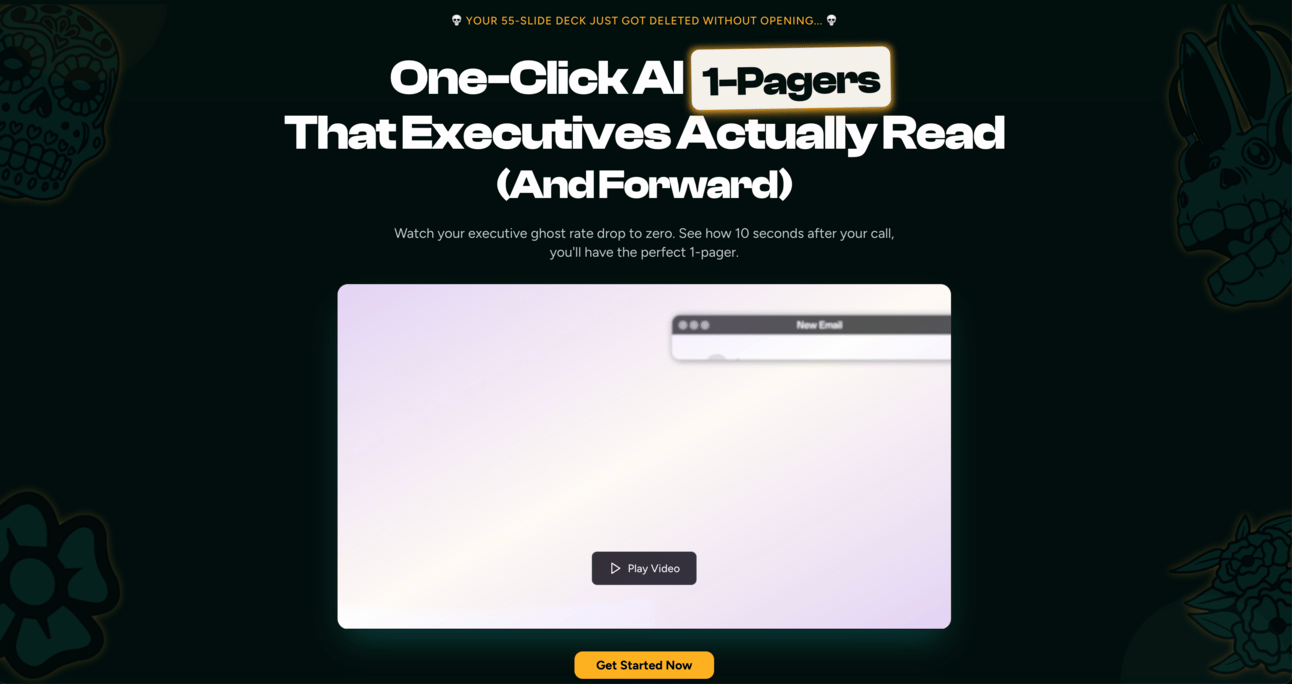- Andy's Newsletter
- Posts
- The follow-up mistake that's killing 73% of your deals
The follow-up mistake that's killing 73% of your deals
Most people do this after every sales call (and wonder why prospects ghost them)
The Follow-Up Mistake That's Killing 73% of Your Deals
Here's a sobering stat: 73% of deals die in the follow-up phase.
Not during the first call. Not because of price. Not even because of competition.
They die because of what you send after the meeting.
And the worst part? You think you're being helpful. You think you're being thorough. You think you're giving them everything they need to make a decision.
You're actually doing the opposite.
The Problem: We're Drowning Prospects in "Helpfulness"
Picture this: You just had an amazing sales call.
The prospect was engaged. They asked great questions. They even mentioned budget and timeline.
So you do what every sales trainer taught you: You send a comprehensive follow-up.
45-slide deck. Implementation timeline. Case studies. ROI calculator. Product demo. Comparison chart.
You hit send feeling like a rockstar. You gave them everything.
Then... radio silence.
Sound familiar? You're not alone. Research from the University of California shows that executive attention spans have dropped from 2.5 minutes to just 47 seconds for sales content.
Your "comprehensive" follow-up just became their worst nightmare.
The Overwhelm Trap (And Why It's Deadly)
Here's what really happens when you send that monster follow-up package:
Your prospect opens your email. They see multiple attachments. Their brain immediately calculates: "This is going to take forever."
They bookmark it for "later." Which, let's be honest, never comes.
They forget about you completely. Out of sight, out of mind.
The irony? You killed the deal by trying too hard to close it.
I call this the Overwhelm Trap, and it's the #1 reason promising deals go dark. You're not losing to competitors. You're losing to cognitive overload.
The One-Thing Rule
The solution is stupidly simple: Send one thing. Make it perfect.
Instead of overwhelming them with options, give them exactly what they need to take the next step. Nothing more. Nothing less.
This isn't about being lazy. It's about being strategic.
The best follow-ups don't try to answer every question. They answer the one question that matters most right now.
Step 1: Identify Their Single Biggest Concern
During your call, listen for the one thing that's keeping them up at night.
Not their wish list. Not their nice-to-haves. Their pain point that hurts so bad they'd pay to make it go away tomorrow.
Most reps try to address 5-7 different concerns in their follow-up. Winners focus on the one that matters most.
Example: If they mention their team is spending 10 hours a week on manual reporting, your follow-up should be 100% about solving that specific problem.
Step 2: Create a Single-Focus Follow-Up
Your follow-up should have one job: Move them closer to solving that one problem.
Not a product overview. Not a feature comparison. Not a company presentation.
A laser-focused piece of content that addresses their specific concern.
This could be:
A one-page ROI calculation for their exact situation
A simple implementation timeline for their use case
A brief case study of someone who solved the same problem
The key? It should take them 60 seconds or less to consume and understand.
Step 3: The "Next Step" Close
End every follow-up with exactly one next step.
Not "Let me know if you have questions." Not "I'd love to continue the conversation."
A specific, time-bound request that moves the deal forward.
"Based on our conversation about your reporting challenges, I've put together a 60-second overview of exactly how we'd save your team those 10 hours per week. After you review it, let's schedule 15 minutes Thursday to walk through implementation. Does 2 PM or 4 PM work better?"
Notice what happened there? One outcome. Clear timeline. Binary choice.
How AI Transforms Your Follow-Up Game
This is where AI becomes your secret weapon.
Instead of spending 2 hours crafting the "perfect" comprehensive follow-up, you can generate a targeted, single-focus piece of content in 2 minutes.
Here's my go-to AI prompt for follow-ups:
AI Follow-Up Generator:
Based on this sales call summary: [PASTE CALL NOTES]
Create a single-focus follow-up that addresses their biggest concern: [SPECIFIC PAIN POINT]
Requirements:
- One clear outcome only
- 60 seconds or less to read
- Include specific next step with timeline
- Format as [email/one-pager/proposal]
- Keep it conversational and direct
Focus area: [ROI calculation/implementation timeline/case study/problem solution]This prompt eliminates the guesswork and gives you exactly what your prospect needs to hear right now.
Your Follow-Up Reality Check
Here's the truth: Your prospects don't want more information. They want the right information.
The One-Thing Rule works because it respects their time and matches how executives actually make decisions. They want to see one clear path forward, not a buffet of options.
Stop trying to impress them with how much you know. Start impressing them with how well you listen.
– Andy
PS... Are you still sending those comprehensive follow-up packages that nobody reads?
I get it. It feels wrong to send "just one thing" when you have so much value to share. But here's what I've learned after analyzing thousands of sales follow-ups...
The ones that get forwarded to decision-makers are always one page or less.
Inside Distribute, our AI sales 1-pagers, you get follow-up content that executives actually read and share. It helps you focus on the one thing that matters most in just 60 seconds, instead of overwhelming prospects with information they'll never consume.
No more 45-slide decks dying in email purgatory. No more "comprehensive" follow-ups that kill deals.
